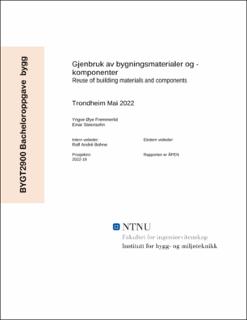| dc.contributor.advisor | Bohne, Rolf André | |
| dc.contributor.author | Fremmerlid, Yngve | |
| dc.contributor.author | Steensohn, Einar | |
| dc.date.accessioned | 2022-07-05T17:20:39Z | |
| dc.date.available | 2022-07-05T17:20:39Z | |
| dc.date.issued | 2022 | |
| dc.identifier | no.ntnu:inspera:106805903:113642045 | |
| dc.identifier.uri | https://hdl.handle.net/11250/3002851 | |
| dc.description.abstract | Overforbruk og befolkningsvekst har ført til at vi i dag kan observere klimaforandringer og en økende uttømming av ressursene i verden. Klimaforandringene viser seg i form av forhøyet temperatur, hyppigere forekomst av ekstremvær og naturkatastrofer, og et høyere havnivå. Stadig økende befolkning, komfortkrav og forbruk har satt jordens befolkning i en situasjon som krever umiddelbar handling. På bakgrunn av dette har FN utarbeidet en internasjonal klimaavtale, med målsetning om et klimanøytralt samfunn innen 2100. Norge er et av medlemslandene i denne avtalen.
For å oppnå klimamålene satt av FN er Norge avhengig av å redusere både klimagassutslipp og ressursforbruket. Byggebransjen står ansvarlig for store deler av både utslipp og forbruk, og må stilles til ansvar for sitt eget miljøavtrykk. I sammenheng med klimamålene har sirkulær økonomi vokst frem med økende popularitet som en mer gunstig modell enn dagens lineære økonomi. Sentralt i den sirkulære økonomien står gjenbruk. Denne bacheloroppgaven har gjennom litteraturstudier forsøkt å samle relevant data, erfaringer og kunnskap som belyser utfordringene og mulighetene for en storskala implementering av ombruk og gjenvinning i byggebransjen, samt hvilke materialer som er mest aktuelle.
Resultatene viser at det er en lav grad av ombruk i bransjen per i dag, og dermed er det et potensiale for en oppskalering. Det kommer klart frem av arbeidet at en slik oppskalering krever endringer i alle ledd. Både økonomiske, praktiske, samfunnsmessige og kulturelle endringer må skje. Det har vist seg vanskelig å tallfeste mengder av materialer tilgjengelig for gjenbruk fra den tilgjengelige avfallsstatistikken, og dermed vanskelig å anslå med nøyaktighet utviklingen gjenbruk vil ha i fremtiden. Likevel vil en endring i dagens riveskikk fører til at mengden ombrukbart materiale vil øke i fremtiden.
Videre er ombrukspotensialet til en rekke ulike materialer og produkter trukket frem og vurdert i oppgaven. Også her støter man på vanskeligheter da det er mange faktorer som regnes som prosjektspesifikke, og en generell ombruksverdi ikke nøyaktig kan anslås. En oppskalering vil trolig tjene mest på at enkelte materialgrupper prioriteres skjer først, for å utvikle sikre og effektive ordninger på testing, dokumentering og logistikk.
En omlegging av hele byggebransjen der det bygges for og med ombruk vil ta tid, penger og vilje. Det krever fagfolk med tverrfaglig kompetanse som er innovative og villige til å tråkke opp nye stier for andre. Til gjengjeld vil det åpne opp for ny industrivirksomhet og skape flere arbeidsplasser. | |
| dc.description.abstract | Overconsumption and population growth has led us to see the climate change and a growing depletion of the world’s natural resources. Climate change is showing in the form of elevated temperature, more frequent occurrence of extreme weather and natural disasters, and a rise in sea levels. The continuous increase of the world’s population and consumption in combination with a rising demand for comfort has led us to a situation that demands immediate action. Based on this, the UN has drawn up an international climate agreement, with the goal of being a climate neutral society by 2100. Norway is one of the signed countries in this agreement.
In order to reach the climate goals, set by the UN, Norway is dependent on minimizing both greenhouse gas emissions and the resource consumption. The construction industry is responsible for a major part of the worlds, and Norway's, emissions and resource consumption, and need to be held accountable. With background in the climate goals, the concept of circular economy has gained popularity as a more favourable model rather than the current linear model. A key component to the circular is reuse. This thesis makes an effort to compile and review available literature, experiences and knowledge regarding possibilities and difficulties surrounding a large-scale implementation of reuse i the construction industry. The thesis also seeks to investigate and discuss which building materials and components might be best suited for reuse.
The results shows that the industry, as of today, have a low degree of reuse in general, thus have a potential for up scaling. It is evident that such a large-scale implementation requires big and intrusive changes in every stage of the construction process. Both economic, practical, societal and cultural changes need to happen. It has been a difficult task to get exact numbers quantifying reusable materials based on the available waste statistics in Norway, and therefor also difficult to predict exactly how the practise of reuse will grow in the future. Nevertheless, a change in how to demolish buildings will most likely lead to more available reusable material in the future.
Furthermore, the thesis discusses the potential for reuse in a range of different materials. Also, at this stage significant challenges occurred. Since there are many project specific elements to consider when discussing the potential it is hard to give an quantifiable value to each material or component. A scaling of the reuse market would likely benefit from choosing some select materials and develop safe and efficient routines for testing, documentation and handling.
A shift in the industry in which the focus is on building for and with reusable materials is going to take time. The process needs innovative professionals with interdisciplinary expertise, willing to thread new paths for other to follow. In return it will establish new industries and open up for new fields of work. | |
| dc.language | nob | |
| dc.publisher | NTNU | |
| dc.title | Gjenbruk av bygningsmaterialer og -komponenter. | |
| dc.type | Bachelor thesis | |
